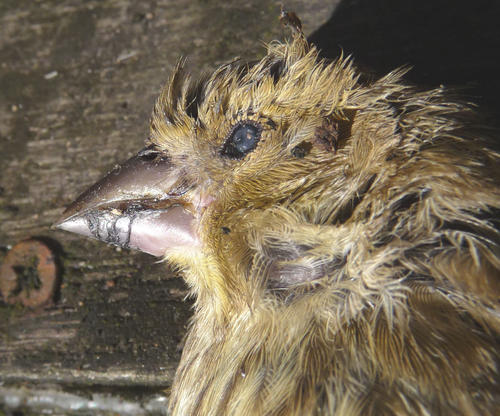Trichomonas gallinae – Trichomoniasis in wild birds. An update 2010
Harry Green
I reported on the severe outbreak of this disease previously (Green 2006) in Worcestershire. Since 2005 many people have found dead and dying Greenfinches in their gardens, often near bird feeding stations, and usually in late summer. At times Chaffinches and House Sparrows also seem to suffer similar problems. Birds suffer from many diseases but these particular outbreaks are caused by a disease commonly called canker, an infection that has been well-known in wild, feral and racing pigeons for many years, and technically called Trichomoniasis. The disease appears to again have been particularly severe since summer 2010 with many reports of a complete lack of Greenfinches at many garden feeding stations during the autumn and first part of the winter.
The infection affects the mouth and upper gullet of the bird and the sick birds may drool saliva, regurgitate food and have difficulty in swallowing although they try to eat. There may be wet matted feathers around the face and beak, and food may get stuck in the mouth. The birds look sick, are lethargic, and sit about doing nothing with feathers puffed up. The disease progress is slow and the bird eventually starves to death. Internally the throat may be blocked by ulcerating growths and the crop distended. The disease is caused by a microscopic protozoan parasite called Trichomonas gallinae, and the individual organisms of the disease are single-celled animals far bigger than bacteria although they can only be seen with a microscope.
The disease seems to affect small birds that habitually live in flocks. Greenfinches are a particularly unfortunate species in this respect as their lives are spent in flocks and even when nesting they form loose colonies and do not defend large breeding territories occupied by one pair like most other small birds. On fledging the flocks of young and old birds stay together, roost together and forage together. Biologically this is probably because they are seed eaters and their food tends to be found in small rich clumps rather than scattered through a habitat. The communal behaviour provides plenty of opportunities for the disease to pass from one bird to another through saliva. Also it is now thought that the disease is mostly passed from adult to chicks in the nest when the chicks are fed by a parent regurgitating partly digested seeds. This probably explains why outbreaks occur in late summer soon after youngsters have fledged and is seen at garden feeding stations when the flocks of young and old birds arrive to feed. It is likely that some birds carry the disease without being ill. Pigeons also feed their nestlings by regurgitation of “pigeon’s milk”.
There is considerable worry that the disease may be spread further at garden feeding stations. This could be so but nobody knows for sure. As a precaution good hygiene around feeders may help prevent the spread of this and perhaps other diseases. The organism causing the disease does not survive long outside the bird and is easily killed by drying out. If you find dead greenfinches in your garden a good precaution may be to stop feeding for a fortnight, give all the feeders a really good clean and let them dry thoroughly for several days before re-filling with food. The same applies to bird baths and drinking places. It is advisable to wear washing-up gloves or similar when cleaning up feeding stations. Trichomoniasis does not affect people but rarely birds may carry other bacterial diseases which can affect people so taking reasonable care is sensible.
Nationally this disease appears to be causing a decline in Greenfinch numbers as shown by survey work undertaken by the British Trust for Ornithology (BTO). A recent brief report gives provisional information (Toms 2010). Analysis of the national Garden BirdWatch data for 2006 compared with previous years showed reporting rates in gardens fell by about 20% in places badly affected by the disease and this fall was not seen elsewhere. Furthermore the 2007 data from the national Breeding Birds Survey (BBS) showed a decrease of 35% of greenfinches in areas where the disease was prevalent compared with previous years. It appears that Trichomoniasis is causing a drop in Greenfinch numbers. However it is worth remembering that other diseases caused by bacteria that also kill birds and it is often difficult to know what exactly causes a change in bird numbers. Further research is needed.
Further information on Trichomoniasis can be found at the following web sites:
http://www.ufaw.org.uk/documents/GBHI_Trichomonas_sheet_2010_.pdf
http://www.bto.org/gbw/news/disease_outbreak.htm
http://www.rspb.org.uk/advice/helpingbirds/health/sickbirds/disease.aspx
References
GREEN G H 2006. Trichomonas gallinae – Trichomoniasis in wild birds. Worcestershire Record. 21:18-19.
TOMS, M. 2010. Trichomonosis hits greenfinch numbers. BTO News. Issue 291, page 15.

